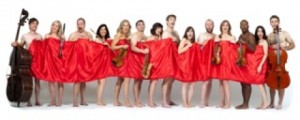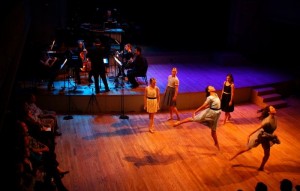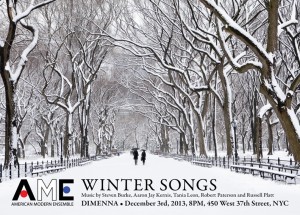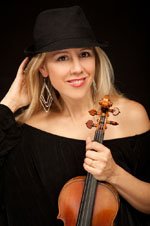From Greg:
Victoria will explain how she and I happened to meet, and strike sparks from each other. What excited me was the large audience she gets for the American Modern Ensemble, the new music group she runs with her composer husband, Robert Paterson. I fear I can be a broken record on the subject of audience, but I’m not going to stop saying that classical music needs new listeners. At new music concerts I’m saddened by seeing only 20 or 30 people in the audience, or seeing a repeating group of insiders, And I’m saddened, too, when I hear from a friend in Washington — a sincere and passionate supporter of new classical music — that the core audience for new music in the city is no more than 50 people.
I can understand why she says this, and why the audience is so often small, and why so many people believe this is natural, that the audience for new classical music simply isn’t big, and can’t be big. Because, after all, the small — or insider-based — audience is what we’ve seen for so long. But in my experience groups with small audiences aren’t, as a rule, doing much to get a larger one.
Enter Victoria. And, of course, many others who share her energy and optimism. But as you’ll read, she simply won’t accept a small audience, and to read what she does to get a larger one, along with many other useful tips on how to run a successful (if underfunded) ensemble, and pay your musicians a decent fee — I think all this is inspiring. Victoria has her priorities straight. Over to her!
Here are three quotes from reviews, which sum up my American Modern Ensemble better than anything I can write, and perhaps explain why we pack the house time and time again:
Devoting a program to Minimalist and microtonal compositions could easily amount to an egghead agenda; leave it to the American Modern Ensemble to make it a party instead.
– The New York Times
 First off, this concert was fun, and the house was packed. If there is, in fact, an audience-building issue in the new music scene, part of it may be that the enjoyment factor is left out of the discussion. The conversation is always about whether people are used to hearing this kind of music, if they understand it, or if they are open to it. But at the recent American Modern Ensemble performance…the most prevalent impression I walked away with was that I’d come to a really fun party, with the music as the entertainingly rousing guest of honor. (And, of course, there was wine — good wine at that.)
First off, this concert was fun, and the house was packed. If there is, in fact, an audience-building issue in the new music scene, part of it may be that the enjoyment factor is left out of the discussion. The conversation is always about whether people are used to hearing this kind of music, if they understand it, or if they are open to it. But at the recent American Modern Ensemble performance…the most prevalent impression I walked away with was that I’d come to a really fun party, with the music as the entertainingly rousing guest of honor. (And, of course, there was wine — good wine at that.)
Second, the players were excellent. Of course many, like pianist Stephen Gosling and clarinetist Benjamin Fingland, are well-known staples of the New York new music scene. Okay, so nothing new, you might say. But the tight chamber playing and the intense communication passed between artists who’ve played together a lot brought out the bang in each piece. From the most silent moments to the most joyously skittish, I was sucked into the mood evoked by each. Listening to and watching the musicians of the American Modern Ensemble is like experiencing a “perfect ten” dance team with the mystical element of music emanating from their own bodily movements. This is the way to hear new music — when each work is in a symbiotic relationship with those playing it. These musicians have the brazen audacity to interpret the new (for new music takes courage). Their adventurousness is addictive.
Third, the composers were not only great, they were present and engaged…
We couldn’t help but dance in our seats and chuckle at motifs because, after all, the act of listening — well, it needs to be fun, too.
– Seen and Heard International
Pessimists about the future of classical music may be looking in the wrong places. There were empty seats at the Metropolitan Opera’s estimable “Aida” on Friday night, but on Saturday, “Powerhouse Pianists” filled the Tenri Cultural Institute to its gills, with standees crowding the rim of this small West Village gallery and hopeful ticket buyers stretching out onto 13th Street. The American Modern Ensemble is new this year and dedicates its time to American composers… This is a worthwhile new organization with what seems a strong fan base.
– The New York Times
How this started
I met Greg Sandow on the last day of the League of American Orchestras conference this past June in St. Louis. It was my first time attending and it won’t be my last. I was there with my Executive Director hat on for American Modern Ensemble, American Modern Recordings, and on behalf of my composer husband, Robert Paterson. Greg and I totally hit it off, and had a blast talking and sharing ideas about classical music, modern music and how to make it all work in New York City.
Robert Paterson and I began American Modern Ensemble almost 10 years ago. We started with a recital at the Greenwich House Music School with just piano and violin (another hat I wear is playing the violin). I titled it “Concert of American Music” and there were works by Robert, and by Aaron Jay Kernis, Andrew Waggoner, and William Bolcom. The concert was a present to myself for finishing up six months on the road as concertmaster of the touring company of Beauty and the Beast. The concert was lovely with all composers there except Bolcom.
This spurred the idea to do another concert of Robert’s music at the Tenri Gallery on 13th Street. Tenri was a great venue and another success. Finding a venue that looks good if 40 people are attending or 140 people attending is key when starting out. The location is critical, as are affordability, and the general vibe you want to create. This art gallery gave us all this, plus a nice Steinway grand. Our next question was whether we would start an ensemble as Steve Reich and Philip Glass did. In other words, would we just do the music of Robert Paterson?
We decided to go with celebrating American music by many living composers as our mission. Robert was our house composer but we also programmed many other vibrant wonderful folks. To date, AME has programmed over 150 composers, giving four to twelve concerts each season and holding a yearly composer contest with prizes that include monetary awards, a NYC performance, and a recording.
The way we go from the conception of an idea to mounting a real event, and having it all come together, never ceases to amaze me. Simply put, this doesn’t “just happen.” Here are some inside observations about how it all came together over the years.
Teamwork
AME is a team. In general, players do not just show up, play great, and then take off. Things work when there is a collective responsibility to help out. In our case, this does not mean having players write grants, do bookkeeping, or make publicity postcards. There are other groups that divvy up those job duties as well, but in our group, myself, Robert, and some interns and part-time assistants do the administrative work.
What the players do may seem small but it isn’t small to me. I urge each of them to bring two to four of their fans, friends, and family to each show. Perhaps the percussionist gets his aunt to give $60 each season, or the violist has a neighbor or friend who can give $100. The cellist has his friends buy four CDs. The players stick around after our concerts and meet the audience. The composers bring their fans and friends. The composers always do an informal 10-minute post-intermission chat. They stick around and meet the audience and hang out with the players. Players help me book runout shows, or give me other leads for possible gigs. They also help by getting good deals on percussion rentals, harp rentals, and other things, you name it.
We all at one point or another help move chairs and marimbas, get pizza, carpool, etc. Sometimes the players do big things, like getting us a big runout concert in New Jersey that pays thousands of dollars, or leading me to a major patron. But to me, even when they do the little things I mentioned, it is all one and the same.
Fair pay
And let’s talk about pay. Players are paid fairly. We all work on Broadway and play in some of the top orchestras and chamber groups in New York. Everyone must get paid enough for AME shows to feel just fine turning down other work to play with us. Gone are the days when I or anyone I hire will do a concert for $100 to $200, a low fee that includes rehearsals. AME does an average of two to three rehearsals and a dress rehearsal for each concert, and everyone is paid $350 to $800 per show, depending on various factors such as rehearsal time and how many pieces each player is involved in.
Shockingly, I got a criticism this past year from a leading new music organization (which shall go unnamed), saying that AME pays musicians too much and that we spend too much on PR! That is insane. So we should be a scrappy new music ensemble that pays almost nothing, has no PR and doesn’t think big picture? So it is not valuable that we have had many New York Times reviews, along with print articles in non-music publications like Sports Illustrated and Vegetarian Times, and even a three-minute television interview feature on the Jumbotron screen at Citi Field, where the New York Mets play? It wasn’t valuable that this interview was shown for three weeks? This criticism speaks to a sense of smallness in classical music that I am against. It is my passion to have modern music be mainstream, and to broaden the audience in a big way.
And just a word about how we got into Sports Illustrated and on the Jumbotron. Robert wrote a piece called Batter’s Box for tenor and piano, inspired by the life of Mike Piazza, the Mets superstar catcher. This piece was featured in the New York Times. Sports Illustrated must have read the piece and then they showed up to our concert and did an article. Then, the Mets must have read either Sports Illustrated or the Times, because they found us and asked to do an interview. And then made the video they showed on their Jumbotron, which you can watch here. In this case, our PR people did not make these things happen. My guess it was a spiral affect originating from the Times article.
The Vegetarian Times piece came directly from our PR firm reaching out to the magazine, because Robert and I are vegetarians and love Vegetarian Times. We asked our publicists to pitch our story, and the magazine went with it, and did a feature. A defeatist attitude is not helpful with PR, or for that matter, with life in general!
Dance and opera
 AME also collaborates. We just had a knockout show at Roulette in Brooklyn, with the Mazzini Dance Collective and Ear Heart Music. Modern dance and live music fit like a glove, as does music and modern art. Here’s a video of the dance show at Roulette. I know that we’ll revisit modern dance in upcoming shows.
AME also collaborates. We just had a knockout show at Roulette in Brooklyn, with the Mazzini Dance Collective and Ear Heart Music. Modern dance and live music fit like a glove, as does music and modern art. Here’s a video of the dance show at Roulette. I know that we’ll revisit modern dance in upcoming shows.
AME is collaborating with American Opera Projects next year, also at Roulette, performing operas by Robert and by Tarik O’Regan. Every time we collaborate we broaden our audience in a big way, and get a wonderful new mix of people, ranging widely in age and interests. They may not all come to every show we present in the future, but even six to ten new audience members are worth whatever work it takes to find them.
Another trick I learned right away from my Broadway days: to paper the house at the last minute, as needed. I don’t want be stubborn and just have a small house. A concert without an audience is not worth having. It’s like not having a concert at all. I sadly just toured New England with a chamber orchestra, and there was an average of 25 to 50 people in the house, with almost 20 people on stage. This is such a buzzkill for a performer. The presenters should have just papered the house to fill those seats, end of story. Get people hooked and even if one in four of them return, that is a victory.
AME rents mailing lists once in a while, to great effect. Entertex — an arts marketing firm that rents mailing lists — is a company I have used, and it has never been more than a couple hundred dollars for various chamber music lists. It really helps if you want to target dance, vocal music, chamber music, or a particular neighborhood you’d like to hit. We still send postcards to advertise our shows. And this may be surprising news: promoting our shows with email blasts and on Facebook and Twitter doesn’t have the same impact. These things haven’t done very much to actually get people in the door. Not to say that we shouldn’t have a website, and shouldn’t use Facebook, email blasts, and Twitter. I’ve heard there’s a marketing rule that says someone has to see something seven times for it to sink in. Maybe that’s what’s happening here.
 However, the postcards have always been a hit for AME. Our graphic designs are outstanding, and although I have not done a scientific study, I feel that at our events we always get the best results from the cards. On the right is the postcard for our next show, which is on Tuesday, December 3, at Dimenna, 450 W. 37 Street in New York. Tickets are $10 online and $25 at the door. (Another good incentive to fill seats ahead of time is have a big savings available for advance ticket sales online).
However, the postcards have always been a hit for AME. Our graphic designs are outstanding, and although I have not done a scientific study, I feel that at our events we always get the best results from the cards. On the right is the postcard for our next show, which is on Tuesday, December 3, at Dimenna, 450 W. 37 Street in New York. Tickets are $10 online and $25 at the door. (Another good incentive to fill seats ahead of time is have a big savings available for advance ticket sales online).
The chicken and the egg
Lastly, I can’t stress enough how important it is for nonprofits to have solid funding from private supporters as well as public ones. Even ticket sales from a sold-out show don’t make a dent in the cost of producing it. They might cover the cost of putting two to four players onstage. We can bemoan the small ticket price we have to charge, which on average is $10 to $30 for a new music concert, or even for a regular chamber music concert. But come what may, that is the going rate.
AME has a chicken and egg problem in that we do not have sufficient cash to get a staff to help us get more grants and private donations. We raise enough money to pay the production cost for each concert, including the venue, rehearsal space, artist fees, scores, percussion rental, postcards, and other things. But we have nothing left over for our administrative costs. Those are paid with sweat equity, meaning that myself, Robert and many others do tons of unpaid prep work for concerts, volunteering endless time and energy to make it all happen. However, I am optimistic that as we hit our 10th season next year, donors and funders will step up and give us a healthy boost to help cover not only the artist fees, hall, rehearsals, etc, but also the administrative work. I also look forward to being presented more by others, and to move away from the cost and work of presenting ourselves.
So there are endless hats that we constantly throw on and off: administration, fundraising, programming, grantwriting, audience development, program and postcard making, website design, computer tech. We also have a record company (that could be a whole other article). And, last but not least, the core of it all: terrific vibrant music. Celebrating American works and Robert’s music is clearly my passion or I would have quit long ago, after years of so much sweat equity. Hearing the audience enthusiasm, getting standing ovations, making albums, making videos, seeing all these wonderful composers and musicians thriving — these things make me want to “keep on truckin’,” as Peter Schickele (PDQ Bach) urged us, when he sent in his yearly donation. Every person surrounding me is key to our sustainability and growth.
 Victoria Paterson is a violinist in great demand for her musicality and diversity. Equally comfortable with classical and popular music, she performs everywhere from Carnegie Hall, Birdland and Madison Square Garden to Late Night with David Letterman and The Today Show. She played for Chelsea Clinton’s wedding and performs for luminaries ranging from Michelle Obama, Diane Sawyer and Nancy Pelosi to Sean Combs and Jennifer Lopez. She is the founder of the Lumiere String Quartet which performs regularly, and her recordings boast top selling classical sales on Amazon and iTunes. Founder of the American Modern Ensemble, Victoria is passionate about celebrating American music and American composers. She is on the faculty at Western Connecticut State University, and summers in Estes Park, CO at the Rocky Ridge Music Center, where she is also on the faculty.
Victoria Paterson is a violinist in great demand for her musicality and diversity. Equally comfortable with classical and popular music, she performs everywhere from Carnegie Hall, Birdland and Madison Square Garden to Late Night with David Letterman and The Today Show. She played for Chelsea Clinton’s wedding and performs for luminaries ranging from Michelle Obama, Diane Sawyer and Nancy Pelosi to Sean Combs and Jennifer Lopez. She is the founder of the Lumiere String Quartet which performs regularly, and her recordings boast top selling classical sales on Amazon and iTunes. Founder of the American Modern Ensemble, Victoria is passionate about celebrating American music and American composers. She is on the faculty at Western Connecticut State University, and summers in Estes Park, CO at the Rocky Ridge Music Center, where she is also on the faculty.
Film and television credits include Smash, The Social Network, The Celebrity Apprentice, Nurse Jackie, and So You Think You Can Dance. Victoria’s Broadway credits include The Addams Family (Concertmaster), West Side Story, Wicked, Cinderella, Cabaret, South Pacific, and Porgy & Bess. Off-Broadway shows include Giant, The Thing about Men, and I Love You, You’re Perfect, Now Change. Favorite tours: Barbra Streisand, Fiddler on the Roof, Ragtime, Titanic, Sunset Boulevard, and My Fair Lady. Most memorable engagements: Pink Martini, Jewel, K.D. Lang, Joss Stone, YES, Chris Botti, Harry Connick Jr, and Pope Benedict XVI.

Terrific post and ideas…Inspiring…THANK YOU!
A great post with a great story. Thanks, Victoria and Greg.
Thanks Victoria – fantastic comments. We’re doing much the same here in New Zealand with NZTrio but have learnt much from your article. Look out for NZTrio on a screen at an All Blacks game!
Congratulations to the American Modern Ensemble! I’m glad to see that there are some modern pieces with some melody to them and that there is actual cultural diversity in this ensemble. So many other genres of music (like jazz) have shed their cultural exclusivity years ago. Classical music still is not there yet, but to try to attract audiences in a diverse country like the US, you have to be open. It is good to see that some of Mr. Sandow’s-and others-advice is being taken to heart.
Really it doesn’t seem you have to fully re-invent the wheel when it comes to having more people interested in classical music. I’m a relatively young classical music lover. The popularity of artists like Charlotte Church and Josh Groban (even though they are crossover artists) shows that there is a market for this type of music among people of various ages. All that is needed is to have more melodic music being played and artists on stage that reflect the diversity of the US and you’re set. (Pardon the long post!)
There has always existed groups of performers fighting their way into the “sun ” and the
American Modern Ensemble is just one group in a long historic line of musical groups fighting
their way for recognition ,nothing new here.
Comparing the Met and its empty seats to the Tenri is laughable,
it’s comparing an elephant to a mouse.Mrs . Paterson does present us with an interesting study
in how her group strives to survive , but much seems reinventing the wheel of self promotion .
To take her suggestion and watch the “dance show ” at Roulette does give one pause to think
of how both the music and choreography have nothing original about them and one wished she had something more substantial to recommend .But that it satisfies the needs of her audience is all that matters .